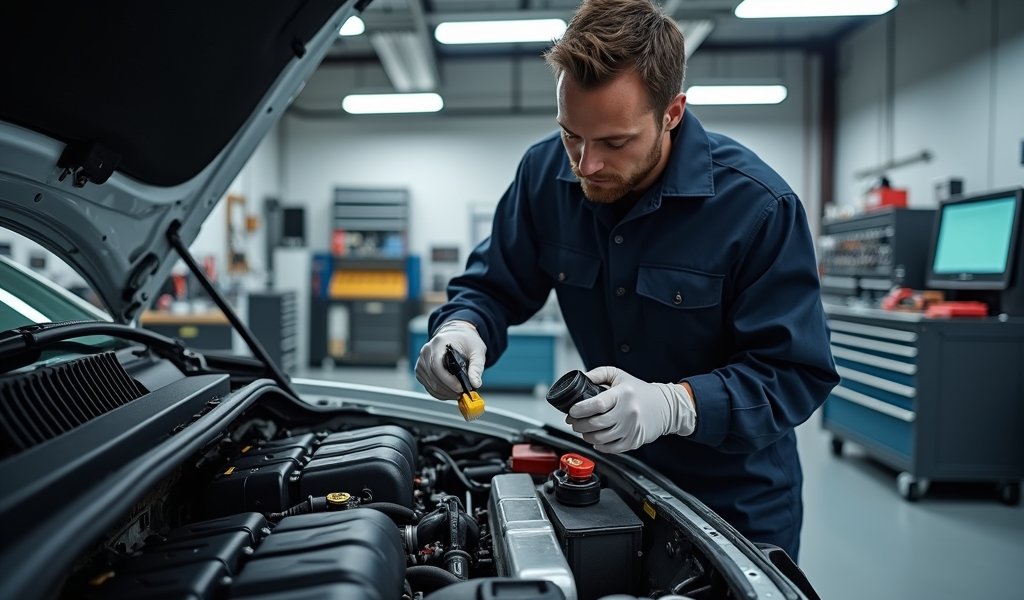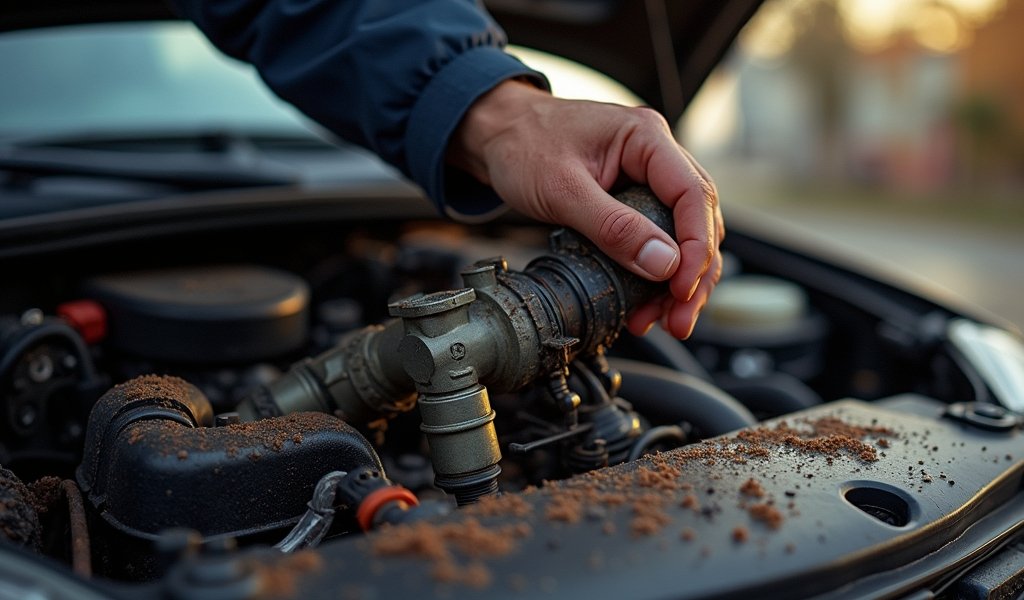Overview
This article provides a detailed guide to cleaning idle air control valves (IACVs), explaining how a dirty valve causes erratic idling, stalling, and poor acceleration, while offering step-by-step cleaning instructions using basic tools and specialized cleaners. The guide covers proper reassembly techniques, troubleshooting after cleaning, and preventative maintenance tips to extend the time between cleanings and improve overall engine performance.
Table of Contents
- Understanding the Idle Air Control Valve
- Signs of a Dirty IACV
- Tools and Materials Needed
- Step-by-Step Cleaning Guide
- Professional Cleaning Techniques
- Reassembly and Testing
- Troubleshooting After Cleaning
- Maintenance Tips
- Conclusion
- Frequently Asked Questions
Understanding the Idle Air Control Valve
Ever wonder what keeps your engine running smoothly at a stoplight? That’s where your idle air control valve (IACV) comes in. This small but mighty component is basically your engine’s air traffic controller when your foot’s off the gas.
In simple terms, the IACV regulates how much air enters your engine during idle, maintaining that perfect RPM balance. When it’s clean, your engine purrs like a kitten. When it’s dirty, well… that’s when the headaches start.
Located typically on the throttle body or intake manifold, the IACV works by receiving signals from your engine’s computer. Based on factors like engine temperature and electrical load (think: A/C or headlights), it adjusts airflow accordingly. This keeps your engine from stalling when these systems demand extra power.
Different vehicles use different IACV designs—some use a rotary valve style, others use a pintle-type arrangement. Newer models might even integrate IACV functions into electronic throttle bodies. Despite these variations, they all serve the same purpose: maintaining stable idle speed under varying conditions.
Signs of a Dirty IACV
Your car has its own language, and when that IACV gets gunked up, it definitely lets you know. The most common tell-tale sign is an erratic idle—your tachometer dancing between 500-1200 RPM for no apparent reason. It’s like your engine can’t make up its mind!
Other symptoms that scream “clean me” include:
- Stalling when you come to a stop (especially embarrassing at busy intersections)
- Hesitation or stumbling during acceleration
- Hard starting, particularly when the engine is cold
- Your check engine light illuminating with idle-related codes
Most drivers don’t realize these issues often stem from carbon buildup on the IACV. According to AA1Car Automotive Diagnostic Help Center, carbon deposits from fuel combustion gradually accumulate on the valve, restricting its movement and disrupting airflow.
I usually recommend cleaning your IACV every 50,000-75,000 miles as preventative maintenance, though this can vary depending on your driving habits and environment. City drivers facing constant stop-and-go traffic might need more frequent attention.

Tools and Materials Needed
Before diving into this DIY job, let’s round up everything you’ll need. Trust me, there’s nothing worse than having your engine partially disassembled and realizing you’re missing something essential!
For tools, you’ll want:
- Socket set and/or screwdrivers (typically Torx or Phillips head)
- Pliers for handling hose clamps
- Clean shop towels
- Small brush (an old toothbrush works wonders here)
- Container for keeping track of small parts and screws
As for cleaning products, this is where you need to be selective:
- Throttle body or carburetor cleaner (NOT brake cleaner—it can damage plastic components)
- Electronic parts cleaner (for electrical connections if needed)
And don’t forget safety equipment:
- Safety glasses (those cleaning sprays can splash)
- Chemical-resistant gloves to protect your skin
- Good ventilation or an outdoor workspace
A service manual for your specific vehicle is also invaluable, especially if this is your first time tackling this job. Many are available online through resources like ALLDATAdiy, which provides vehicle-specific repair information.
Step-by-Step Cleaning Guide
Now for the fun part—let’s get our hands dirty (then clean again)!
Locate Your IACV
First things first: find that valve! The location varies by vehicle, but it’s typically mounted on or near the throttle body. On some vehicles, it’s easily accessible; on others, you might need to move some components out of the way. Your service manual is your best friend here.
Safe Removal
Before touching anything, make sure your engine is cool and disconnect the negative battery terminal. This prevents any accidental electrical shorts while you’re working.
Now, carefully disconnect the electrical connector from the IACV. Most have a small tab you’ll need to press while gently pulling the connector free. Next, remove any vacuum hoses connected to the valve, noting their positions (a quick photo with your phone works wonders).
Remove the mounting screws or bolts holding the valve in place. Keep track of these—they have a magical way of disappearing into the engine bay, never to be seen again!
The Cleaning Process
Once removed, inspect the valve for carbon deposits. Trust me, even on a seemingly well-maintained vehicle, you’ll likely be surprised by the amount of gunk hiding in there.
Hold the valve over a container and spray it generously with throttle body cleaner. Use your brush to gently scrub away deposits, paying special attention to air passages and sealing surfaces. For stubborn deposits, a short soak (5-10 minutes) in cleaner can help loosen things up.
If your valve has a pintle (a moving plunger inside), ensure it moves freely after cleaning. This movement is crucial for proper operation.
For electrical components, use only electronic parts cleaner and allow them to dry thoroughly before reassembly. Remember, we want to clean the valve, not drown its electronics!
Professional Cleaning Techniques
Want to know how the pros get those valves looking factory fresh? Here are some techniques I’ve perfected over years in the shop.
The Overnight Soak
For severely clogged valves, nothing beats an overnight soak. Place the disassembled valve (metal components only) in a small container with enough throttle body cleaner to submerge it. Cover the container and let chemistry do the hard work overnight. By morning, even stubborn carbon deposits will have softened enough to brush away easily.
The Ultrasonic Approach
In professional shops, we often use ultrasonic cleaners for precision parts. These machines use sound waves to create microscopic bubbles that blast away dirt and deposits from even the tiniest crevices. If you have access to one, it’s a game-changer for IACV cleaning.
Type-Specific Techniques
Different IACV designs require slightly different approaches:
- For rotary valves: Focus on the bore where the valve rotates, ensuring it turns freely after cleaning
- For pintle-type valves: Make sure the pintle moves smoothly in and out without sticking
- For integrated electronic throttle bodies: Clean only the air passages and avoid excessive spray on electronic components
What NOT To Do
In my years as a mechanic, I’ve seen well-intentioned DIYers make some cleaning mistakes that ended up costing them. Avoid these pitfalls:
- Never use brake cleaner on your IACV—it can damage plastics and seals
- Don’t force the pintle or butterfly components with tools
- Never submerge electronic components in cleaning solution
- Avoid using compressed air unless you’re certain it won’t damage delicate internal parts

Reassembly and Testing
Now that your IACV is sparkling clean, it’s time to put everything back together. This isn’t just about reversing the removal steps—there are some nuances to get right.
Gasket Considerations
If your IACV uses a gasket, inspect it carefully. Even if it looks okay, replacing it is often the smart move. A failing gasket creates vacuum leaks that cause the same idle problems you’re trying to fix. If you can’t get a new one right away, ensure the original is completely clean and undamaged.
Proper Torque
When reinstalling the mounting screws or bolts, avoid the temptation to crank them down. Over-tightening can warp the valve housing or damage the gasket. If you have a torque wrench, aim for the manufacturer’s spec (typically 8-12 Nm).
Post-Cleaning Test Drive
After reassembly, reconnect the battery and start your engine. Let it reach normal operating temperature and observe the idle behavior. Try turning on various electrical loads like headlights, A/C, and the radio to see how the engine responds.
During your test drive, pay attention to how the engine behaves during deceleration and at stops. A properly cleaned IACV should maintain a steady idle in all conditions, without the drama of rises and dips in RPM.
Troubleshooting After Cleaning
Sometimes, even after a thorough cleaning, idle issues persist. Don’t worry—this doesn’t mean you’ve done anything wrong. Here are some common post-cleaning scenarios and how to address them:
Idle Still Fluctuates
If your idle continues to bounce around, your engine’s computer might need to “relearn” its idle parameters. This is especially common in modern vehicles with adaptive learning systems. The simplest solution is to drive normally for several days, allowing the system to recalibrate.
For some vehicles, you can speed up this process with a specific idle relearn procedure. These vary by manufacturer, so consult your service manual or look online for your specific model.
Check Engine Light Returns
If that pesky light comes back on after your cleaning job, use an OBD-II scanner to retrieve the specific fault codes. Idle-related codes might indicate there’s another issue at play, such as a vacuum leak or a failing sensor.
When Cleaning Isn’t Enough
Sometimes, cleaning just won’t cut it. Signs that your IACV might need replacement include:
- Physical damage to the valve body or pintle
- Electrical failure (no response when connected)
- Pintle still sticks after thorough cleaning
- Vehicle runs worse after cleaning
If you’ve given cleaning your best shot and still have issues, it might be time to invest in a new valve. Quality aftermarket replacements are often available at a fraction of the dealer price, while providing comparable performance and longevity.
Maintenance Tips
An ounce of prevention is worth a pound of cure, especially when it comes to your IACV. Here are some pro tips to keep that valve cleaner longer between servings:
Fuel Quality Matters
Higher-quality fuels contain more detergents that help keep your fuel injectors clean and minimize carbon deposits. If premium isn’t in your budget, consider using a quality fuel system cleaner every 5,000-10,000 miles.
Driving Habits
Short trips with a cold engine are a recipe for carbon buildup. When possible, combine errands into longer drives that allow your engine to reach full operating temperature. This helps burn off deposits before they can accumulate.
Complementary Maintenance
Your IACV doesn’t exist in isolation. These maintenance items directly impact its cleanliness:
- Regular air filter replacement prevents debris from entering the intake
- Timely spark plug replacement ensures efficient combustion
- PCV system maintenance prevents oil vapors from contaminating the intake
- Installing a throttle body spacer can improve airflow and reduce carbon buildup in some vehicles
Conclusion
A clean idle air control valve can transform your driving experience from frustrating to fantastic. Those embarrassing stalls at stoplights, the annoying rough idle that makes your car sound sick—all potentially fixed with a few hours of DIY maintenance and some basic cleaning supplies.
The beauty of IACV cleaning is that it’s accessible to most home mechanics with basic tools and a bit of patience. You don’t need specialized equipment or years of training—just the willingness to get your hands a little dirty and follow the steps outlined above.
Not only will a clean IACV improve your daily driving comfort, but it can also enhance fuel efficiency and reduce emissions. It’s one of those rare win-win maintenance tasks that benefits both your wallet and the environment.
Remember, your car is a complex system of interconnected components. When one part struggles, it affects everything else. By giving your IACV some TLC, you’re contributing to the overall health and longevity of your vehicle.
So next time your engine acts up at idle, don’t rush to the dealer for an expensive fix. Try this cleaning procedure first—you might just save yourself hundreds of dollars and gain the satisfaction of solving the problem yourself!
Frequently Asked Questions
How often should I clean my idle air control valve?
Most mechanics recommend cleaning your IACV every 50,000-75,000 miles. However, vehicles regularly driven in stop-and-go traffic or dusty conditions may need more frequent cleaning.
Can a dirty IACV damage my engine?
A dirty IACV typically won’t cause engine damage directly. However, the resulting poor idle quality can lead to increased fuel consumption and unnecessary wear on engine mounts.
How much does professional IACV cleaning cost?
Professional IACV cleaning typically costs between $80-150 depending on your location and vehicle. DIY cleaning costs only about $10-15 for cleaning supplies.
Can I drive with a bad idle air control valve?
You can drive with a dirty IACV, but you’ll experience stalling, rough idling, and potentially poor fuel economy. In severe cases, the car might not idle at all when stopped.
Will using premium fuel help keep my IACV cleaner?
Premium fuels generally contain more detergents that can help reduce carbon buildup throughout your fuel system. For maximum protection, use a quality fuel system cleaner every 5,000-10,000 miles regardless of fuel grade.


Pingback: Throttle Body Bore Diameter Proven Fixes - knowsyourcar.com